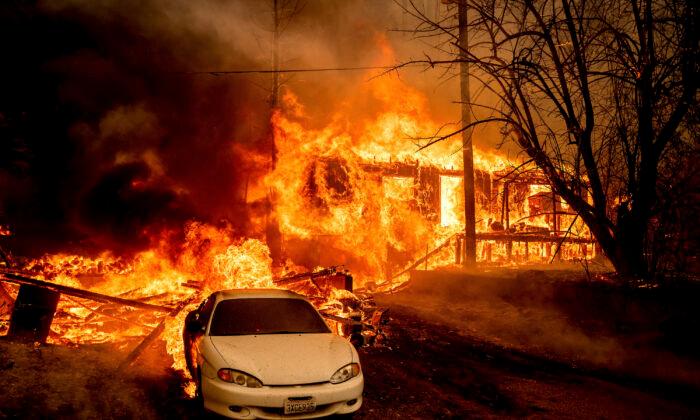Another major insurance provider has announced it’s no longer selling new policies for personal and business properties in California, becoming the latest insurer to reduce its footprint in the state amid inflationary pressures and growing exposure to wildfire risks.
Allstate, the fourth-largest provider of casualty and property insurance in California, said in a statement obtained by The Epoch Times that it had “paused” providing new homeowner policies in the Golden State last year so that it can “continue to protect current customers.”
“The cost to insure new home customers in California is far higher than the price they would pay for policies due to wildfires, higher costs for repairing homes, and higher reinsurance premiums,” Allstate said in the statement.

California Insurers Pull Back
Word that Allstate has halted sales of new insurance policies for home, condominium, or commercial properties in California comes on the heels of a similar decision last week by State Farm, the state’s biggest homeowner insurance provider.State Farm said that inflationary pressures and rising exposure to wildfire risks stood behind its decision to discontinue providing new policies to homeowners.
State Farm said it “made this decision due to historic increases in construction costs outpacing inflation, rapidly growing catastrophe exposure, and a challenging reinsurance market.”
As in the case of Allstate, existing customers will not be affected by the change.

‘Turbulence in California’s Insurance Market’
The American Property Casualty Insurance Association (APCIA), a trade association for home, auto, and business insurers, said in a recent statement that “turbulence in California’s insurance market” harms residents as insurance companies face regulatory constraints.APCIA president and CEO, David Sampson, said in the letter that the cost of insurance has increased “dramatically” in recent times and that California regulations aren’t flexible enough to allow companies to raise rates to mitigate rising risk “due to climate change, historic economic inflation, and legal system abuse.”
He said one key problem is that California’s insurance market operates under an “outdated” statute dating back to 1988 that is too rigid to adapt to the increased risk of droughts and wildfires.
He called for California’s insurance regulatory framework to be modernized.
“The insurance market should not be reliant on a system developed 34 years ago, before the advent of the internet, email, and cell phones,” Sampson wrote.
He said insurers are engaging with California state regulators and policymakers to “find forward-looking solutions to help California insurance consumers and work to rebuild the state’s insurance marketplace to bring back more options for consumers.”
“Insurers do not want to retrench in one of the nation’s most important markets, but cannot continue to operate and deliver on our promises when we cannot manage our own risk exposure,” he wrote.
“Insurers must have the financial strength to deliver on our promises to policyholders when disaster strikes.”
In its statement, State Farm said: “We pledge to work constructively with the CDI [California Department of Insurance] and policymakers to help build market capacity in California.Inflation and Insurance
In a statement reacting to the State Farm announcement, APCIA said that inflation was making “every aspect involved in an insurance claim” more expensive.“It is costing more and taking longer to rebuild homes after a covered loss,” said Mark Sektnan, APCIA vice president for state government relations.
“There’s also a shortage of contractors. And we’re seeing hotter, drier weather—and more wind—which leads to more wildfires. So, all these things are coming into play at the same time.”
In his statement, Sektnan pointed to the “outdated” 1988 statute and insurance regulatory framework that doesn’t let insurance companies adapt to increased risks associated with droughts and wildfires.
He said that in order for the California insurance market to expand its capacity and availability of coverage for personal and business properties, insurers need “greater stability and regulatory flexibility to navigate the current difficult market conditions and manage rapidly evolving risk.”
“The California Department of Insurance (CDI) is working with insurers towards achieving adequate rates and making other market improvements because the admitted market continues to struggle with inadequate rates that don’t cover the increased risks caused by climate change and the growing number of communities in wildfire-prone areas,” Sektnan added.
The insurance squeeze has also affected parts of California where the wildfire risk is low, such as San Francisco.





